“Sorbes de la nuit d’été,” ca. 1975, Pastel and typewriter ink on paper, 13 ¾” x 9⅛”
Joan Mitchell Retrospective SFMOMA
by Linda Saccoccio
What stands out for you regarding Joan Mitchell?
Besides being a colorist, her bold brilliance is seen in the graphic quality of her work. She is direct. She created paintings that capture and contain. Walking into the Joan Mitchell Retrospective at SFMOMA, I was met with her deliberate, striking, energetic line work and color, raw and sharp. There is a powerful thrust forward in the overall quality of the pictorial plane. She has lifted the veils and allows us to face her experiences both the art and life, unapologetically. You can hardly walk away from the clarity, and identity sharp and resolute. She demands and commands the viewer’s attention. She has orchestrated the numinous and the concrete experience with blatant sincerity. There is no sense of hesitation. She knows her medium, a conductor of all the elements she reaches for and inhabits. It feels like an eternal romance. It speaks as a daring invitation that says, bring it on, all of this life!
Though I was familiar with the beauty, elegance and dancing strokes of color in her work, I didn’t know the full story. This retrospective gives Mitchell her due, while it trains the viewer in her magnificent navigation and integration of visual, sensory experience. The vitality of her work will haunt the viewer long after the show with ineffable significance.
We see her influences, especially painters such as Monet and Van Gogh, as well as the French countryside itself. The light is unmistakable. Vibrance of sunflowers comes through with felt sensibility. Yet it is not limited to the pastoral. The paintings are like a room full of people interacting at a fine party. There is a connecting tension that pulls you in then carries you out only to retrieve you again. She contains the painting with an open frame rather than bleeding the lines off the edges. In this way they reverberate within the plane. This airy frame reminds us that this is an artist’s response to her life, a direct experience that is a frame on a reel of a movie.
Not only do Mitchell’s lines speak and evoke, but the color throbs with flavor. As with Kandinsky, there is a collective experience, an intermingling of senses. The use of yellows, blues, lavender, is fragrant and palpable. Life on earth is celebrated, but not without dissolution. Shapes are articulated with vivid energy and persistence, while a sense of deconstruction echoes winds of change, evolution and cycles. Some marks tap the scene with the strike of a typewriter. Others dab the surface like dappled sunlight and shadows on a stone wall or on the ground. There is less a shimmer and a quake.
There is a reminder in many of her paintings of the life of the lotus, nourished in the mud, uplifted through water to present in air and light, fully awakened. Mitchell’s work is fully realized, immediate, on cue.
 “City Landscape,” 1955, Oil on Linen, 80” x 80”
“City Landscape,” 1955, Oil on Linen, 80” x 80”
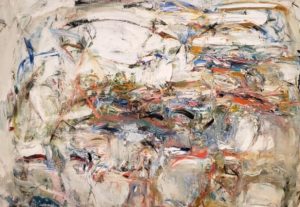
“Swamp,” 1956, Oil on Canvas, 63” x 91 ½”
Upon entering the first room, met by the paintings, “City Landscape” (1955) and “Swamp” (1956), the stature and the value of these works are immediately apparent. They command presence, their own and that of the viewer. Layered and caressed, these works call for a monumental place of delight. They invigorate with a richness both diverse and cohesive. It’s straight up being. One might feel they are with a profound teacher who shares their stories and views. It’s apparent you are about to be given the chance to enter the fields of profundity. It is nothing short of staggering to view this survey of a master’s life.
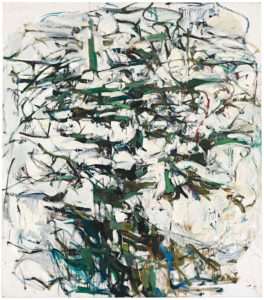
“Hemlock,” 1956, Oil on Canvas, 91” x 80”
There are works like, “Hemlock” (1956) that are predominantly white with black gestural lines yet the color that is woven through, earthy, piney greens, various blues and khaki dotted with warm vermillion, are elegantly offered to create an energetic fortitude stopping your eye, up and down the face. It vacillates between grace and structure.
 “Untitled,” 1956, Oil on Canvas, 24” x 19 ¾”
“Untitled,” 1956, Oil on Canvas, 24” x 19 ¾”
Another painting from 1956, “Untitled,” calls to the center, two wide horizontal bands, one earthy, one ripe red, struck between with dark ultramarine. The touch of the brush, bold and fluid at once, with plenty of breathing space for the dominant thrust to flow outward. It echoes with the beauty of winter branches by a burbling creek.
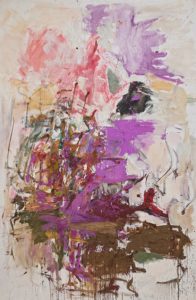 “Untitled,” 1961, Oil on Canvas, 118 ⅛” x 78 ¾”
“Untitled,” 1961, Oil on Canvas, 118 ⅛” x 78 ¾”
This painting holds its poetry in a combination of rugged to smooth washy enclaves. The weight of the painting in the lower third in tones of browns, rises upward in opaque raspberry lavender, buttery yellows and melon rouge. It has a feminine flavor, a mixed tale of summers height and harvest.
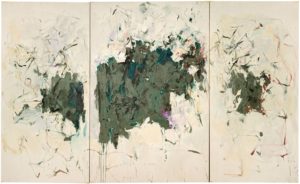 “Girolata Triptych,” 1963, Oil on Canvas, 76 ⅞” x 127 ⅝”
“Girolata Triptych,” 1963, Oil on Canvas, 76 ⅞” x 127 ⅝”
“Girolata Triptych” (1963), with its limited palette predominantly dark terre verte on panels of faintly tanned warm whites, impressions of Mitchell’s time in the coastal village of western Corsica, where Joan frequented, appears as a meditation in three panels on both blocks and breakthroughs. It reads as light and substance. Passages of earthy and viridian greens break through walls of light hinting at stucco rooms. Dabbed minimally with lavender and earthy reds that add to the contemplative feel. It is precise and random with fine drips, hints of time. The thin gestural strokes contrast the three green jagged almost geometric forms give a feeling of ocean breeze. There is a sobering mood with its Zen-like simplicity. There are moments suspended in place.
 “Untitled,” ca. 1964, Oil on Canvas, 20” x 17”
“Untitled,” ca. 1964, Oil on Canvas, 20” x 17”
In the smaller painting, “Untitled” (1964), the color palette resembles a scraped plasticine form articulated by edges of black, planes of deep wine, and stony periwinkle blue. This central form harkens a treetop or an evolving cluster of a hydrangea. Either or neither may be the source of inspiration but among the possible materiality it evokes, it sustains the eye with an elegant statement, edges lost and found, form elevated forward and back. The overall gesture claims the space definitively, ecstatically.
Joan is broadly and finely versed in mark making and this threads through all the passages of her paintings.
 “Ode to Joy (A Poem by Frank O’Hara)”, 1970-1971, Oil on Canvas, 110 ½” x 197 ¼”
“Ode to Joy (A Poem by Frank O’Hara)”, 1970-1971, Oil on Canvas, 110 ½” x 197 ¼”
This monumental sequence of three panels as well as the single panel, “La ligne de la rupture,” both rely on a variety of squares and rectangles with Mitchell’s signature lines. In the triptych, after O’Hara’s poem, Mitchell has captured the broad spectrum of the poet’s words. It carries the essence of the persistence in the poem the multiplicity of life’s trails and joys and ceasing of death. Mitchell’s Ode to Joy, withholds nothing, dark as coffins and steady opportunities for light and eternal flare. I encourage you to read and listen to O’Hara read his poem. It holds hand with the painting as a circle of being.
Marks of color are specific.
 “La Ligne de la rupture,” 1970-1971, Oil on Canvas, 112” x 79”
“La Ligne de la rupture,” 1970-1971, Oil on Canvas, 112” x 79”
In “La Ligne de la rupture” (1970-1971), after the poem by Jacques Dupin, as inferred by the title, there is a rupture. The blocks of color appear stable in place yet on a tilt. The line work is frenetic and short. Some strokes appear like sparks. There is also a sense of ocean foam in the blue and white dabs as a wave may break over a wall below the sparking yellow of light. The painting has weight, solidity, juxtaposed with energetic movement. It holds both a space of holiday with the tension of structures less than secure. It reverberates as many of her paintings do, reflecting inner and outer realms.
 “Daylight,” ca. 1975, Pastel and typewriter ink on paper, 14” x 9”
“Daylight,” ca. 1975, Pastel and typewriter ink on paper, 14” x 9”
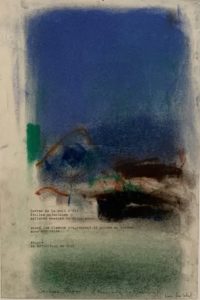
“Sorbes de la nuit d’été,” ca. 1975, Pastel and typewriter ink on paper, 13 ¾” x 9⅛”
In this extensive retrospective there are painterly pastel drawings where Mitchell included poems by friends, James Schyler, Jacques Dupin, and J.J. Mitchell (no-relation). These are from 1975. They were typed on Mitchell’s mother’s Hermes typewriter. They are a bold whisper in the show that highlight Mitchell’s love of poetry, as well as, her articulate touch of surface. Both soft atmospheric and deft in the small areas of mark-making. There is a resemblance with Mark Rothko’s paintings while they remain most definitely Mitchell’s signature. She had a signed copy of Schyler’s, “Hymn to Life,” in her library. Her pastel work meets Schyler’s with a poetic resonance, each able to stand alone, while together they have a sympathetic harmony. These poetic pastels allow viewers a contemplative, delicate entry and are calm in contrast to her more rigorous paintings.
Mitchell’s pastel drawings carry her signature marks with a sensitivity to the materials, softer, delicate, intimate.
 “Red Tree,” 1976, Oil on Canvas, 110” x 63”
“Red Tree,” 1976, Oil on Canvas, 110” x 63”
In 1976, Mitchell painted, “Red Tree,” it shows directly her reverence for nature. Dark branches weave and explode on the surface. It’s a vital gesture of a tree beholden to elements. We sense the weathering and the endurance. The tree persists even in the dead of winter, leafless with energetic promise of return to foliage and flower. It has a solitary and poetic presence as it levitates on the canvas, painted with a limited color palette compared to some paintings in her oeuvre, it evokes a mysterious vision in refractions akin to cut crystal, cordovan branches carve as blue and pink soften with a hint to budding life. The thrust is skyward while the softer hues hold the center like a yearning heart.
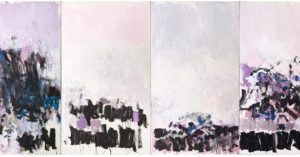
“La Vie en Rose,” 1979, Oil on Canvas, 110 ⅜” x 268 ¼”
Influences, or one might say, true companions of Mitchell, were nature, poetry and music. They come together in many of her works, such as the grand scale, quadriptych painting, “La Vie en rose,”. Apparently this song marked Mitchell’s arrival to Paris synchronistically. As with most of her panels she painted them separately before ordering them together and then adding strokes that unify this deeply moving sequence. The more neutral spaces hold as much weight, if not more, than the strokes of black, heavy determined and passionate calligraphy. Pinks and lavender evoke the rose and lilacs of the season. The contrast of black and white conjures piano keys and the elegance of a theatre, Carnegie Hall where Mitchell saw Edith Piaf perform. The stillness in the atmospheric warm spaces, akin to light through morning fog, are a stage themselves for the defiant ecstatic marks of pleasurable mysterious poetry fields of play. Interiority and intervals have a discourse of time both specific and eternal. In her art we can touch a moment, nature based or human made, and it takes us beyond the fathomable. Mitchell’s La vie en Rose, promises nothing while it delivers unshakable truth. I dare to say this show holds one truth after another, truths to her life in Vétheuil, a small town northwest of Paris as well as the vitality of painting itself. She bridges the worlds of interiority and the quotidian seen and felt. If allowed these works unmistakably are a diary of an artist who had reverence for her life and the act of painting itself. She wields the brush directly, confronting life at large. She has no doubt about the significance of stroke upon stroke, simple and immediate. The show is packed with profundity and lucidity that must be seen in the flesh. The exquisite catalogue serves to jog the memory in detail and offers insights, but nothing compares with witnessing these works that make you shudder at turns, leaving you in awe of her capacity of creativity, real experience in full color and full abstraction, where the abstract does its job by being as real as life.
About the author:
Linda Saccoccio is an artist and writer. She has exhibited across the United States and in Italy. Her poetry has been published in Naropa University’s Summer Writing Program Magazine, and in the Jack Kerouac School of Disembodied Poetics literary journal Bombay Gin, Issue 46: Visionary Hauntology; as well as in the anthologies Buzz, Rare Feathers, and To Give Life Shape, Gunpowder Press. Transitions and Translations is a book of her paintings and the poems that accompany them.


Painting is what allows me to survive….a basic statement by Mitchel that sums up things in terms of what keeps life going in the more general sense